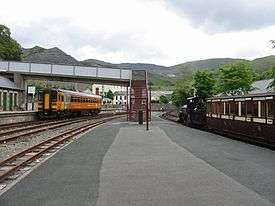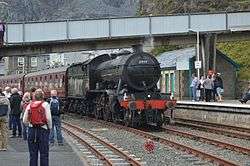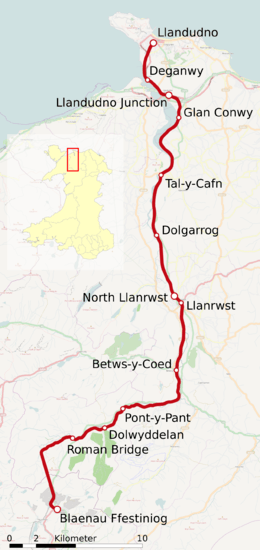Conwy Valley line
| Conwy Valley line | |||
|---|---|---|---|
 Blaenau Ffestiniog, the interchange between Conwy Valley trains and the narrow gauge Ffestiniog Railway | |||
| Overview | |||
| Type | Heavy Rail | ||
| Locale |
Conwy Gwynedd | ||
| Termini |
Llandudno Blaenau Ffestiniog | ||
| Stations | 13 | ||
| Operation | |||
| Opened | 1879 | ||
| Owner | Network Rail | ||
| Operator(s) | Transport for Wales Rail | ||
| Character | Rural | ||
| Rolling stock |
current Class 150 "Sprinter" Class 153 "Super Sprinter" Future British Rail Class 230 | ||
| Technical | |||
| Line length | 30.8 miles (49.6 km) | ||
| Number of tracks |
2 (Llandudno–Llandudno Junction) 1 (Llandudno Junction–North Llanrwst) 2 (Passing loop at North Llanrwst) 1 (North Llanrwst–Blaenau Ffestiniog) | ||
| Track gauge | 4 ft 8 1⁄2 in (1,435 mm) standard gauge | ||
| |||
The Conwy Valley line (Welsh: Rheilffordd Dyffryn Conwy) is a railway line in north-west Wales. It runs from Llandudno via Llandudno Junction (Welsh: Cyffordd Llandudno) to Blaenau Ffestiniog, and was originally part of the London and North Western Railway, being opened in stages to 1879. The primary purpose of the line was to carry slate from the Ffestiniog quarries to a specially built quay at Deganwy for export by sea. The line also provided goods facilities for the market town of Llanrwst, and via the extensive facilities at Betws-y-Coed on the London to Holyhead A5 turnpike road it served many isolated communities in Snowdonia and also the developing tourist industry. Although only a little over 27 miles (43 km) between Llandudno and Blaenau Ffestiniog, the journey takes over one hour, largely due to the sinuous and steeply graded nature of the route taken (particularly south of Betws-y-Coed). Most of the stations along the line are treated as request stops.
History
The first section from Llandudno Junction to Llanrwst (now called North Llanrwst) was built as the Conway and Llanrwst Railway and opened in 1863. The LNWR took over in 1863 and opened the extension to Betws-y-Coed in 1868.[1]
The next extension was to Blaenau Ffestiniog to access the output of the large slate quarries there. At first the LNWR proposed a 2' narrow gauge railway via the steeply graded Lledr Valley to Blaenau Ffestiniog, this being the 'Bettws & Festiniog Railway'; authorisation was sought in November 1870.[2][3] After construction began, it was decided that the extension would be built to standard gauge, allowing through running of trains. Between 1874 and 1879 the railway tunnel underneath Moel Dyrnogydd was bored, and in July 1879 a terminus was initially opened by the tunnel entrance. The line was subsequently extended by the best part of a mile to a terminus in the town, which opened 31 March 1881.[4][5]
Blaenau Ffestiniog's other standard gauge railway, the Bala and Ffestiniog Railway, was closed to all traffic in 1961, and a portion was flooded in the creation of the Llyn Celyn reservoir. A rail connection was desired for the nuclear power station under construction at Trawsfynydd, and a connecting line was built from Blaenau Ffestiniog North to the site of the demolished Blaenau Ffestiniog Central station for freight use. With the reconstruction of the Ffestiniog Railway, passenger services were relocated to a new joint station on the site of the old Central station in 1982. Regular freight traffic to Trawsfynydd ceased in 1995, and the power station is being decommissioned.
The line's proximity to the River Conwy at its northern end has led to periodic problems with flooding over the years. The most recent instance saw the line closed between February and April 2017 after Storm Doris when a tree fell on the track near Pont-y-Pant. Engineers had to move over 300 tonnes of rock and fallen vegetation during the recovery work.[6]
The line was previously closed from 27 December 2015 for seven weeks, after the formation was damaged by floodwater in more than 100 places following heavy rain on Boxing Day.[7] Previous episodes in 2004 & 2005 also resulted in prolonged closures whilst the trackbed & embankments were rebuilt - the 2004 floods putting the line out of action from early February until 22 May that year.[8]
Modern services
The line from Llandudno Junction to Blaenau is single track, and includes the longest single track railway tunnel in the United Kingdom (over 2.2 miles or 3.5 kilometres). The line's summit 790 feet (240 m) above sea level is located mid-way through the tunnel and the gradients either side of it are as steep as 1-in-47 on the southbound ascent through Pont-y-pant and 1-in-43 on the climb out of the terminus at Blaenau for northbound trains.[9]
Between Llandudno Junction and Llandudno the service uses the double track branch line from the North Wales Coast Line. The fully signalled passing loop at North Llanrwst is the last remaining between Llandudno Junction and Blaenau Ffestiniog and trains on the branch must stop at the signal box there to exchange tokens for the single line sections on either side.[10]
The line is currently served by 6 trains per day in both directions from Monday to Saturday between Llandudno and Blaenau Ffestiniog (and vice versa), with the first two southbound services of the day starting (and first northbound service turning back) at Llandudno Junction and terminating in Blaenau Ffestiniog. The service is reduced to 3 trains per day in both directions on Sundays, though the Sunday service only operates in summer (mid May until early September).[11] A rail replacement bus operates in lieu of the train on Sundays for the remainder of the year.
The train service is operated by Transport for Wales Rail and is being marketed as the Conwy Valley Railway (Welsh: Rheilffordd Dyffryn Conwy). A feature of the service is the availability on Conwy Valley trains as well as on local buses in Snowdonia of the new "Tocyn Taith" day ticket.
From 20 May 2007, Concessionary Travel Pass holders resident in Conwy and Gwynedd have been able to travel free of charge on the Conwy Valley Railway line between Llandudno and Blaenau Ffestiniog, as well as between Llandudno Junction and Llandudno on all Transport for Wales Rail services, as a result of funding provided by the Welsh Assembly Government.
The Office of Rail Regulation says [12] 116,500 passenger journeys were made on the line in 2013/14, excluding exits and entries at the main line stations of Llandudno Junction, Deganwy and Llandudno. This was a small increase compared with the figure of 112,134 in 2012/13. Figures show that Blaenau Ffestiniog is the busiest of the line's stations with 44,828 passengers in 2013/14, followed by Betws-y-Coed with 35,400. Other stations have very low footfall with Dolgarrog attracting just 828 passengers in 2013/14.
There are plans to upgrade the line to take slate from Blaenau Ffestiniog to the coast, sponsored by the Welsh Assembly Government[13]
In October 2018 operations transfered to the new franchise holder Transport for Wales Rail who have announced that they will use a British Rail Class 230 D-Train on the line in late 2019. Replacing the British Rail Class 150 currently used on the line.
Community rail
This is designated as a community rail partnership.[14]
Steam workings

Until 1998 steam traction had not been seen on the route since the ending of steam on BR in 1968; in 1998 the first steam working in the preservation era was to run back to Blaenau Ffestiniog from London behind a BR Standard 4 Tank no 80079. The first attempt up the route on 2 May 1998 ended in disaster as the engine stalled near Pont-y-Pant and due to the water supply running low resulted in the train having to be rescued and then returned to Llandudno. A second attempt the day later, this time with just 4 coaches instead of the previous 6 proved successful, with 80079 becoming the first standard gauge steam locomotive in Blaenau for 31 years.
On 1 May 1999 LMS black 5 no 45407 worked "The Conwy Climber" tour from Llandudno Junction to Blaenau Ffestiniog, from the lessons learnt with 80079 it was decided that although 45407 was a power class 5 engine (The BR standard being power class 4) 45407 would take a max of 4 coaches up the line while working solo. 45407 first took up 4 coaches to Blaenau without problems and then returned light engine to Llandudno Junction to collect the remaining four coaches, after this the eight coaches were coupled together for the return trip to Llandudno Junction.[15]
Five months later on 17 October the BR Standard tank no 80079 returned for a rematch on the route, this time she was to haul 4 coaches instead of 6 and she was working the trip with another member of her class no 80098. Once again 80079 slipped to a stand near Pont-y-Pant and 80098, which had been waiting with the second portion of the train at Llanwrst, was detached to bank 80079 up to Blaenau. Thereafter the two engines double-headed the remaining 4 coaches before reforming the train to 8 coaches for the journey back to Llandudno.
In 2009, after a 10-year gap since the BR Standard tanks had worked up the route, "The Railway Touring Company" ran a special under the name "The Welsh Mountaineer" from Worcester to Blaenau Ffestiniog with 2 LMS Black 5's working the train from Llandudno Junction for the journey up the route to Blaenau. The Black 5's chosen for the trip were Bert Hitchen's no 45231 The Sherwood Forester & Ian Riley's no 45407 The Lancashire Fusilier. The locos' support coaches were left at Llandudno for the journey, leaving them with a load of 9 coaches to take up the line's 1 in 47 gradient. After the success of this trip a number of regular "Welsh Mountaineer" trips are run on select Tuesdays from Preston to Blaenau during the summer months, and today these trips are still running. Locos that have visited the route in recent years include: 45231 The Sherwood Forester, 45407 The Lancashire Fusilier, 46115 Scots Guardsman[16], 48151[17] & 61994 The Great Marquess.[18]
Route
The following towns and villages are served by the line:
- Llandudno
- Deganwy
- Llandudno Junction
- Glan Conwy
- Tal-y-Cafn
- Dolgarrog
- Llanrwst (for Trefriw)
- Betws-y-Coed
- Pont-y-Pant railway station
- Dolwyddelan
- Roman Bridge railway station
- Blaenau Ffestiniog
The original line terminated at the North Western station (where there were extensive slate yards) to the west of Blaenau Ffestiniog town centre. However, following the closure and removal of a section of the former Great Western Railway line from Bala, a short section of new railway was built alongside the Ffestiniog Railway Company's narrow gauge line in order to connect the Conwy Valley line with the isolated section of the GWR line, which had been retained to serve the nuclear power station at Trawsfynydd. Years later a new Blaenau Ffestiniog station was constructed in the centre of the town. Beyond the new station, the line was used only for goods traffic connected with Trawsfynydd, although occasional special passenger trains have been run at times. In recent years, the traffic from Trawsfynydd has ceased completely (the last charter special ran in October 1998) and the line has been disconnected from the Conwy Valley line just outside Blaenau Ffestiniog station.
There are connections at Llandudno Junction with the North Wales Coast Line (the main line between London and Holyhead) and at Blaenau Ffestiniog with the Ffestiniog Railway to Porthmadog.
References
- ↑ Baughan 1980, page 117
- ↑ The London Gazette, 18 Nov 1870
- ↑ The Cambrian News and Merionethshire Standard, 26 November 1870
- ↑ Baughan 1980, pages 128-130
- ↑ The North Wales Express, 1 April 1881
- ↑ "Conwy Valley Line set for mid-April reopening following Doris damage". www.railtechnologymagazine.com. Retrieved 28 March 2017.
- ↑ Conwy Valley line had 1,200 tonnes of material removed from railway during repair work Davidson, Tom; Daily Post article 10 February 2016; Retrieved 4 March 2016
- ↑ "Flooding closed the Conwy Valley line for 3 months" – The Conway Valley Line, Penmorfa.com; Retrieved 4 March 2016
- ↑ "The Conwy Valley Line - Blaenau Ffestiniog and the Ffestiniog Railway - Page 1" Penmorfa.com; Retrieved 31 May 2017
- ↑ Photos of Llanrwst station, signal box and crossing loop www.penmorfa.com; Retrieved 2010-06-08
- ↑ GB eNRT May 2017 Edition, Table 102 (Network Rail)
- ↑ "Estimates of station usage". orr.gov.uk. Retrieved 28 October 2015.
- ↑ "BBC NEWS - UK - Wales - North West Wales - Campaign to improve railway link". bbc.co.uk. Retrieved 28 October 2015.
- ↑ "ACORP Summary map" (PDF). Association of Community Rail Partnerships. 28 July 2014. Archived from the original (PDF) on 18 November 2015. Retrieved 28 October 2015.
- ↑ http://www.penmorfa.com/Conwy/steam1.html
- ↑ https://www.dailypost.co.uk/news/north-wales-news/historic-steam-train-arrives-gwynedd-13385877 "46115 on the Welsh Mountaineer
- ↑ "48151 on Welsh Mountaineer railtour, Preston to Blaenau Ffestiniog North Wales Coast Railway: Notice Board article 2 August 2010; Retrieved 31 May 2017
- ↑ "61994, Preston to Blaenau Ffestiniog, 21 August 2012" Penmorfa.com; Retrieved 31 May 2017
Sources
- Baughan, Peter E. (1980). A Regional History of the Railways of Great Britain: Volume 11 North and Mid Wales (1st ed.). Newton Abbot: David & Charles. ISBN 0-7153-7850-3. OCLC 6823219.
- Baughan, Peter E. (1991). A Regional History of the Railways of Great Britain: Volume 11 North and Mid Wales (2nd ed.). Nairn: David St John Thomas. ISBN 0-9465-3759-3. OCLC 26361284.
Further reading
External links
| Wikimedia Commons has media related to Conwy Valley line. |
